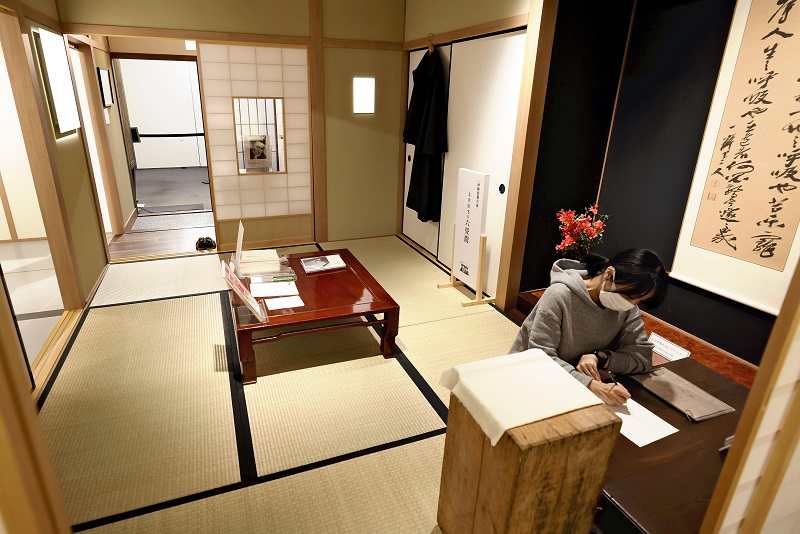
A six-tatami-mat room simulating Osamu Dazai’s study. Visitors can take notes on a small desk or try on a cloak, seen hanging in the background.
10:17 JST, January 11, 2023
The home workplace of novelist Osamu Dazai (1909-1948) has been recreated in Mitaka, Tokyo, where he spent most of his career.
His manuscripts and writing materials are on display at an exhibition area in the Mitaka City Gallery of Art, which is directly connected to JR Mitaka Station. This area, which includes a tatami-mat room simulating his study, is called “Dazai Osamu Tenji-shitsu: Mitaka no Kono Chiisai Ie” (Osamu Dazai exhibition room: This little house in Mitaka).
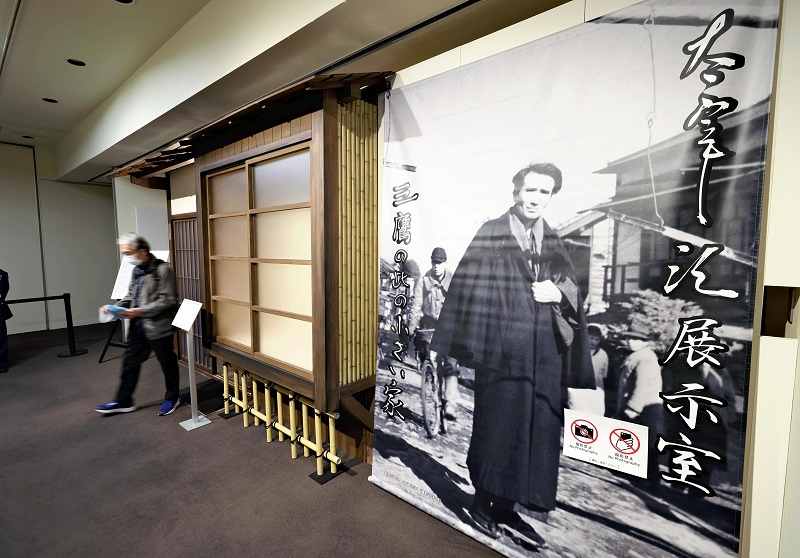
The exterior of “Dazai Osamu Tenji-shitsu: Mitaka no Kono Chiisai Ie”
Dazai lived with his wife, two daughters and a son in a house with rooms that were three, four and a half, and six tatami mats in size, with a veranda. A recreation of the six-mat room that he used as a study and drawing room is near the entrance to the exhibition. It is said that the first thing visitors to his house would see was Dazai hunched over as he wrote at a small table in the study.
An apple crate used as a bookshelf next to the writing desk is also reproduced at the exhibition. Dazai is said to have kept no library, owning only a few books throughout his life.
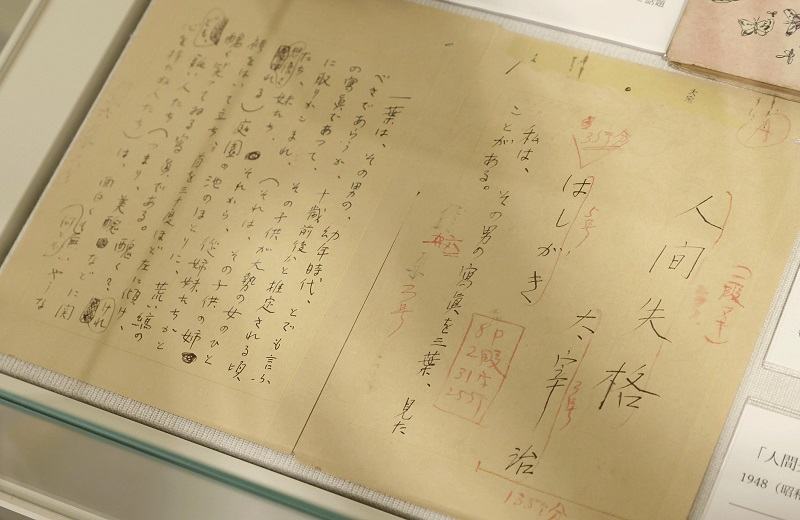
A reproduction of the manuscript of “Ningen Shikkaku” (No Longer Human, also published as A Shameful Life) with revisions
Among items visitors can view in the reproduced three-mat room dedicated to permanent exhibits are a copy of the manuscript of “Ningen Shikkaku” (No Longer Human, also published as A Shameful Life) and the manuscript of the essay “Daion wa Katarazu” (No talk about big kindness), both of which Dazai wrote while living in Mitaka.
Special exhibitions are held several times a year in the four-and-a-half-mat room. The “Dazai Osamu yori: Shinai naru Hiresaki Jun e” (From Osamu Dazai: To my dear Jun Hiresaki) is being held through Jan. 15, introducing the novelist’s exchanges with Jun Hiresaki (1911-1989). Dazai, through a relative, became acquainted with the painter in 1935, and he moved to Mitaka at Hiresaki’s invitation.
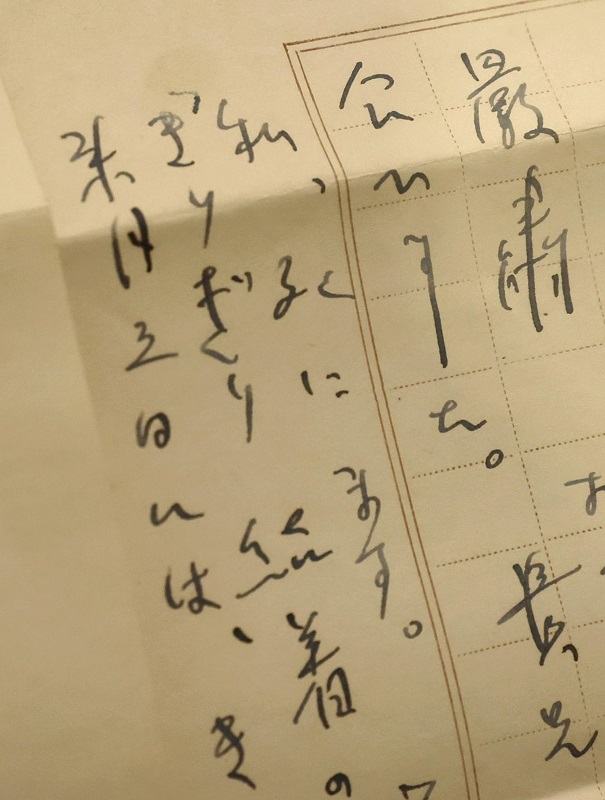
A letter that Osamu Dazai wrote to Jun Hiresaki, desperately asking for a loan
Items on display at the exhibition include letters from Dazai that were preserved by the Hiresaki family. Dazai’s distinctive way of explaining or asking for things is seen in the letters. When asking Hiresaki for a loan in a June 1936 letter, for example, he wrote, “This is my do-or-die, first and last asking in my life,” and “I will die if you refuse to lend me ¥50.”
“Bannen” (Last years), a collection of his works dedicated to Hiresaki, is also on display. The Christian aspects of Dazai’s works are said to reflect Hiresaki’s influence.
Visitors can also view materials showing Dazai’s circle of friends. They include a Kobizen (ancient Bizen ware) flower vase given by his mentor Masuji Ibuse and a postcard that Dazai sent to poet and literary critic Utaro Noda with a hand-drawn map.
“I hope visitors will be able to feel the talent of Dazai, not through copied materials, but through his handwritten letters,” curator Mami Yoshinaga said.
Dazai Osamu Tenji-shitsu: Mitaka no Kono Chiisai Ie
Opened in 2020. The exhibition space takes its name from a line in Dazai’s 1941 work “Dare?” (Who?) that reads, “Mitaka no kono chiisai ie wa watashi no shigotoba de aru” (This small house in Mitaka is my workplace).
Address: Mitaka Coral 5th floor, 3-35-1 Shimorenjaku, Mitaka, Tokyo
Hours: 10 a.m. to 6 p.m. Closed on Mondays and during the year-end and New Year periods.
Admission: Free
Related Tags
"Features" POPULAR ARTICLE
-

Sanrio to Open Museum in Yamanashi Pref. Dedicated to Founder, Exhibits Include Hello Kitty, Other Characters
-
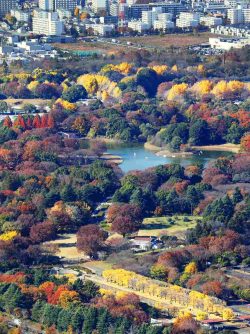
Autumn Foliage Surrounds Visitors to Tokyo’s Showa Kinen Park
-

My Daughter No Longer Speaks to Me, But I Want to See Her and My Grandchild
-

Kumamoto: Public Bath Refurbished as Library Where You Can Chat, Take Photos
-

Frozen Vegetables: Demand Rises for Convenient, Tasty Domestic Produce
JN ACCESS RANKING
-

Keidanren Chairman Yoshinobu Tsutsui Visits Kashiwazaki-Kariwa Nuclear Power Plant; Inspects New Emergency Safety System
-

Imports of Rare Earths from China Facing Delays, May Be Caused by Deterioration of Japan-China Relations
-

University of Tokyo Professor Discusses Japanese Economic Security in Interview Ahead of Forum
-

Japan Pulls out of Vietnam Nuclear Project, Complicating Hanoi’s Power Plans
-

Govt Aims to Expand NISA Program Lineup, Abolish Age Restriction






















